
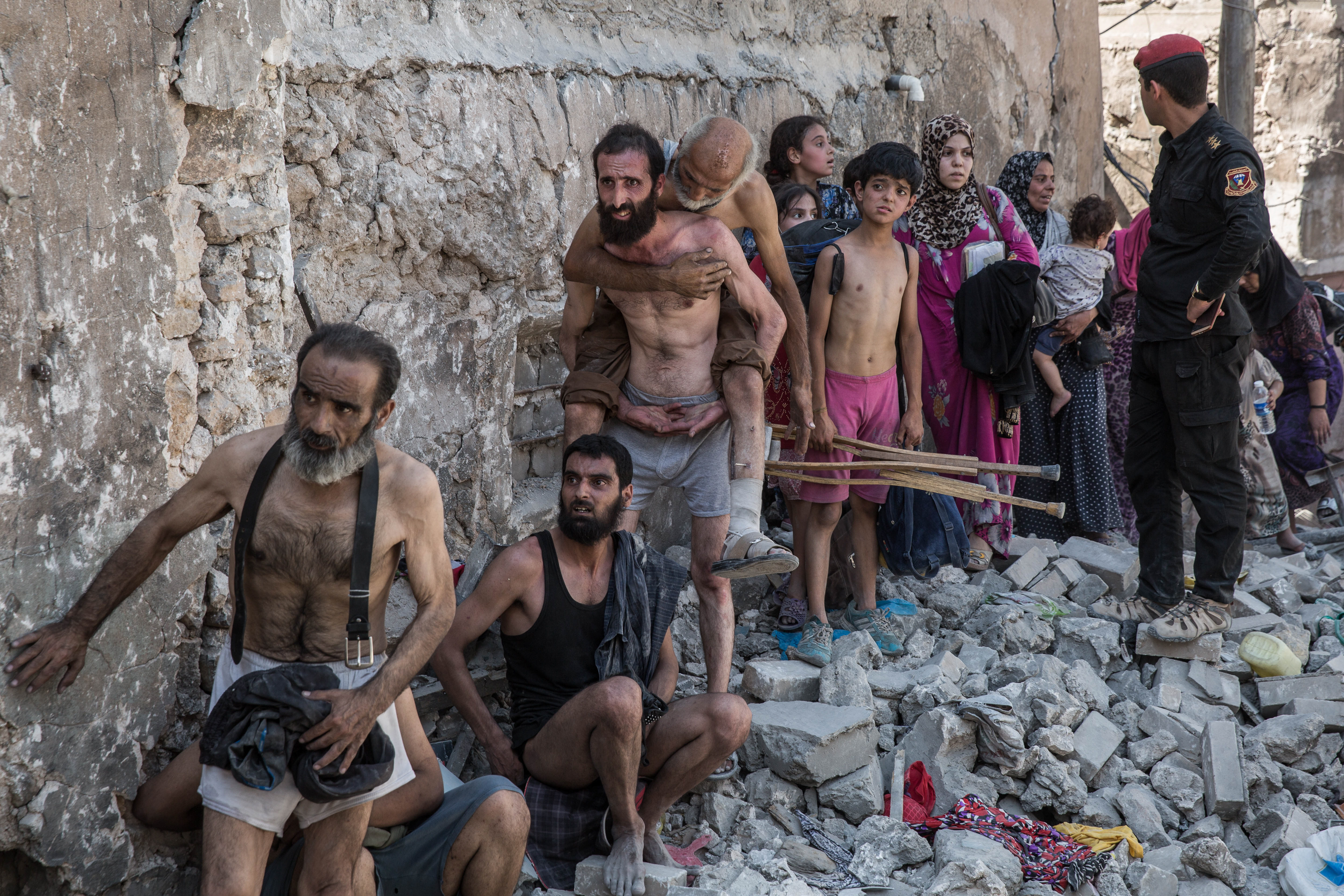
Mosul story @Laurence Geai
Siamo molto orgogliosi di annunciavi che si è completata la prima edizione del premio fotogiornalistico WARS con più di 100 reportage da 36 paesi diversi e 5 continenti. Vogliamo ringraziare tutti i fotografi che hanno condiviso con noi le loro importanti storie da tutto il mondo!
La nostra giuria, composta da tre professionisti punto di riferimento del fotogiornalismo contemporaneo, Carol Guzy, Manoocher Deghati e Alessio Romenzi, ha scelto i seguenti reportage per la prima edizione di WARS Photojournalism Award:
1st Prize: Laurence Geai con Mosul
Finalist: Manu Brabo con The Last European Frontline
Finalist: Dar Yasin con Kashmir Endless War
La giuria, ha inoltre voluto riconoscere con ‘Honorable Mentions’ i seguenti lavori:
Sameer al-Doumy con War Notes
Mustafa Hassona con Palestinian rights of return protests
Le fotografie premiate verranno esposte a Ferrara durante il Festival di Internazionale il 5 e 6 Ottobre 2019, e vi aspettiamo tutte e tutti per la cerimonia di premiazione!
We are very proud to announce that the first edition of the WARS photojournalistic award has been completed with more than 100 reports from 36 different countries and 5 continents.
We want to thank all the photographers who have shared with us their important stories from all over the world!
Our jury, composed by three professional referent points for contemporary photojournalism, Carol Guzy, Manoocher Deghati and Alessio Romenzi, has chosen the following reports for the first edition of WARS Photojournalism Award:
1st Prize: Laurence Geai with Mosul
Finalist: Manu Brabo with The Last European Frontline
Finalist: Dar Yasin with Kashmir Endless War
The jury also want to recognize the following works with ‘Honorable Mentions’:
Sameer al-Doumy with War Notes
Mustafa Hassona with Palestinian rights of return protests
The winning photographs will be exhibited in Ferrara during the International Festival of Journalism, on 5 and 6 October 2019. See you there for the awards ceremony!
Winner – Laurence Geai
Il reportage vincitore | Mosul story
DESCRIZIONE DEL PROGETTO
Mosul è un servizio fotografico sulla città di Mosul in Iraq, che è stata sotto il controllo di Daesh per 3 anni. Ho iniziato il reportage due mesi prima della liberazione di Mosul nel luglio 2017. Si tratta di un lavoro costante a cui sto lavorando ancora oggi. La città, soprattutto la parte vecchia, che è stata quasi totalmente distrutta, soffre molto. Ancora molti civili sono bloccati nei campi intorno alla città. Non possono tornare a casa perché la loro abitazione è distrutta o perché appartengono a Daesh e non sarebbero più i benvenuti. Da due anni nella città la vita sta lentamente tornando. I civili sono tornati, stanno riaprendo negozi e caffè. Questo reportage mostra la resilienza degli esseri umani.
Laurence Geai è una fotoreporter francese. Dopo aver conseguito una laurea in economia internazionale, ha rivolto la sua attenzione al giornalismo, prima per la televisione e poi con la fotografia. Il lavoro di Geai si concentra sui conflitti armati, in particolare con tutto il Vicino Oriente: Siria, Iraq, Israele, Palestina. Le sue opere riguardano anche le conseguenze della crisi dei rifugiati in Europa e Francia. Il suo lavoro è stato pubblicato su Le Monde, Paris Match, The Washington Post, Polka, La Vie, Le Pelerin, Le Nouvel Obs, Libération, Le JDD, Causette, La Croix, M Magazine per Le Monde, Le Parisien, Elle e altri. Premi. 2018: 3rd price in the politic picture award of Science PO. 2018: 1st price «single shot award » of the «festival della fotografia etica » 2017: Photographer of the year Polka 2017.
The winner | Mosul story
PROJECT DESCRIPTION
Mosul is a photo report about the city of Mosul in Iraq, which has been under the control of Daesh during 3 years. I started the report two months before the liberation of Mosul in July 2017. It is a on going report, I am still working on it today. The city suffers a lot especially the old city of Mosul, which has been almost totally destroyed. Still many civilians are stuck in camps around the city. They can’t go back home because their home are destroyed or because they belong to Daesh, and they will not be welcome anymore in their town. Life is coming back slowly, in the old city since two years. Civilians are back, they are opening shops and coffee again. This report shows the resilience of human beings.
Laurence Geai is a French photojournalist based in Paris. After receiving a degree in international business, Geai turned her attention to journalism, first in television then in photography. Geai’s work focuses on armed conflict, especially throughout the Middle East: Syria, Iraq, Israel, Palestine. Her works has also covers the consequences of the refugee crisis in Europe and France. Her work has been published in Le Monde, Paris Match, The Washington Post, Polka, La Vie, Le Pelerin, Le Nouvel Obs, Libération, Le JDD, Causette, La Croix, M Magazine for Le Monde, Le Parisien, Elle and others. Awards: 2018: 3rd price in the politic picture award of Science PO. 2018: 1st price «single shot award » of the «festival della fotografia etica » 2017: Photographer of the year Polka 2017.
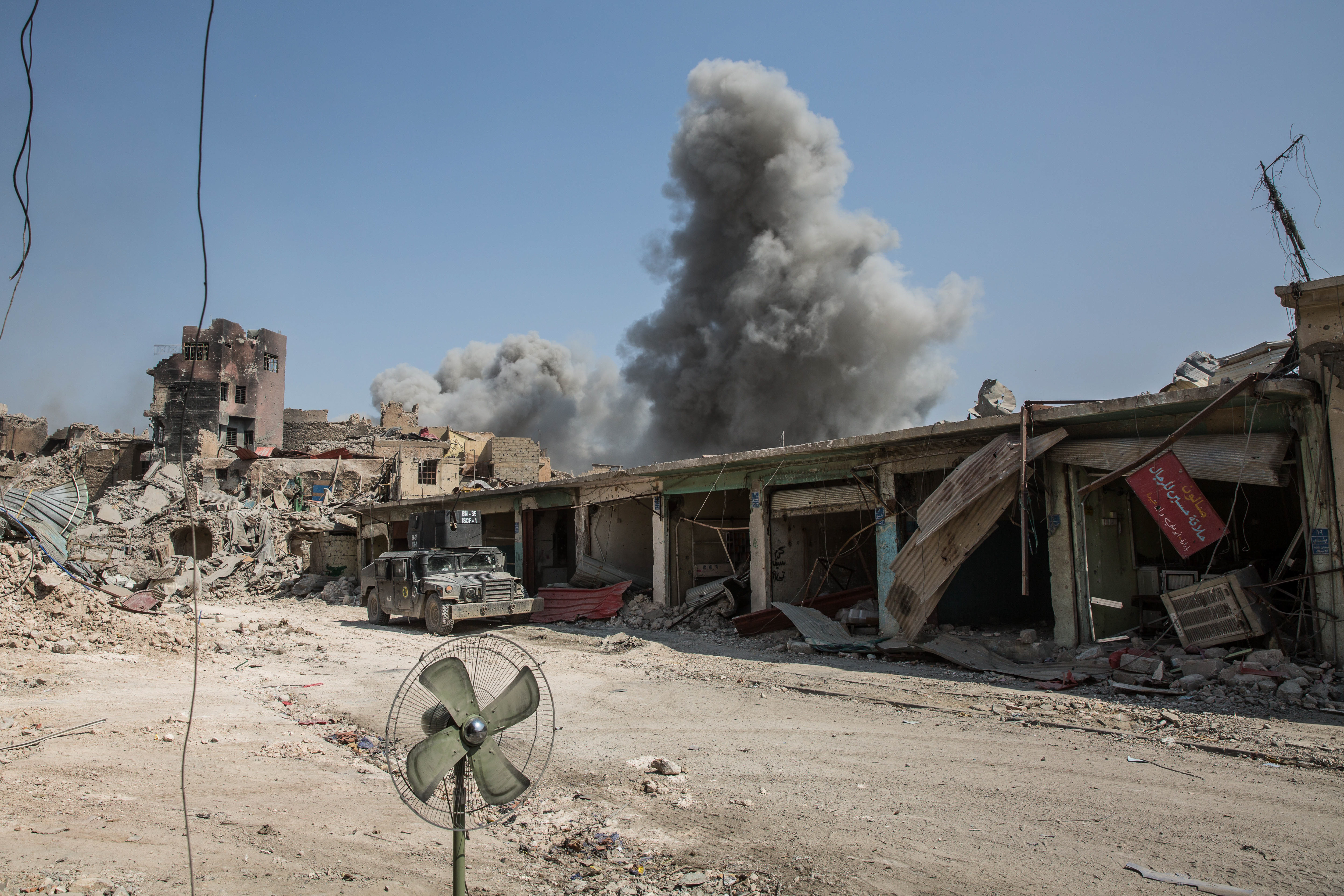
Old city of Mosul. June 2017. A airstrike of the coalition has just taken place in the old town of Mossul. Some daesh fighter are still in the old city.
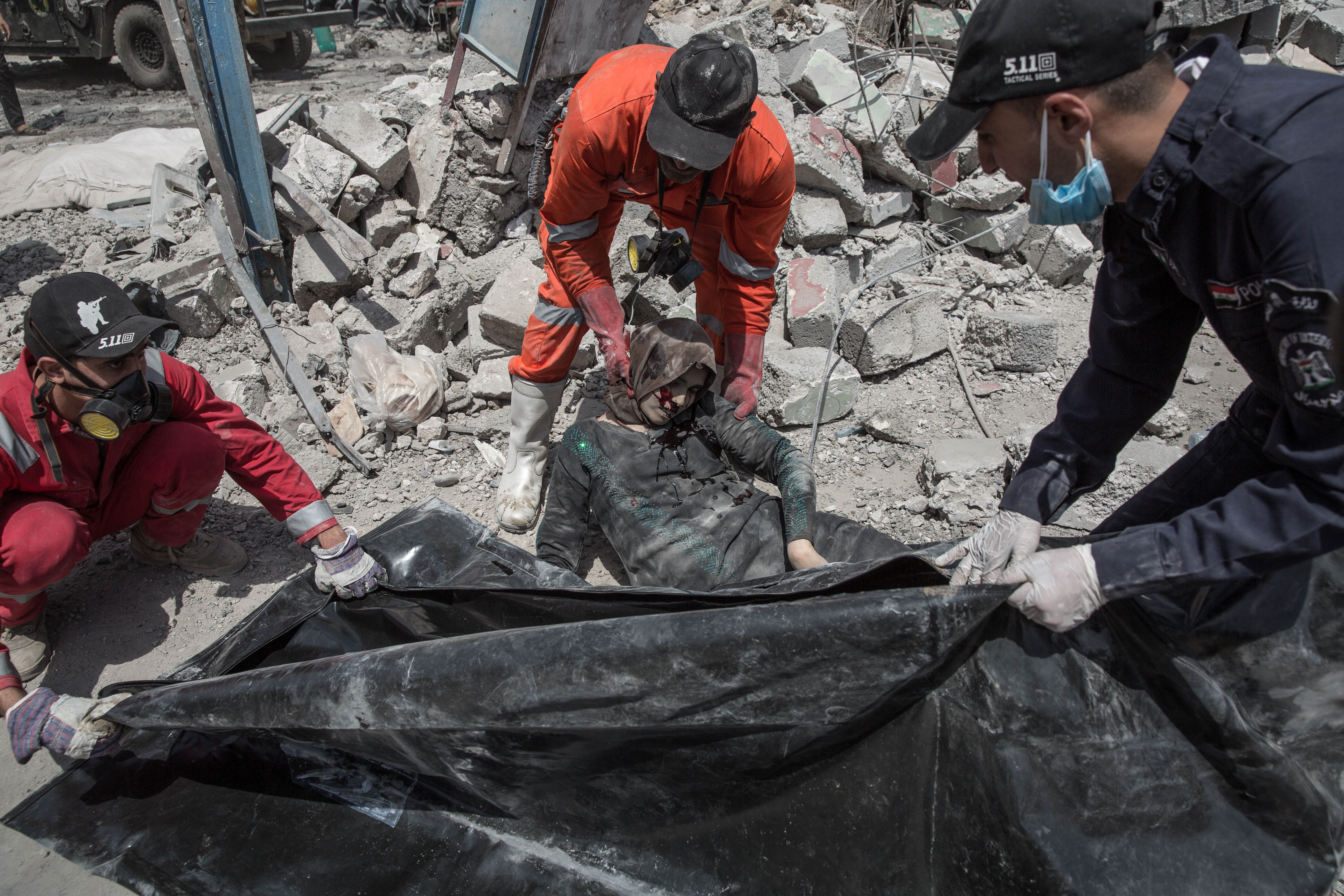
West Mosul. Old city. In July 2017, civilian protection men are tasked with recovering the bodies following an attack by a suicide bomber who has explosed into civilians fleeing the fighting in the old town of Mossul. 7 lifeless bodies are in the floor. Including this young woman. Many jihadist women hid in the flood of civilians fleeing the fighting in the old city. Unlike men, women are never searched for cultural reasons.
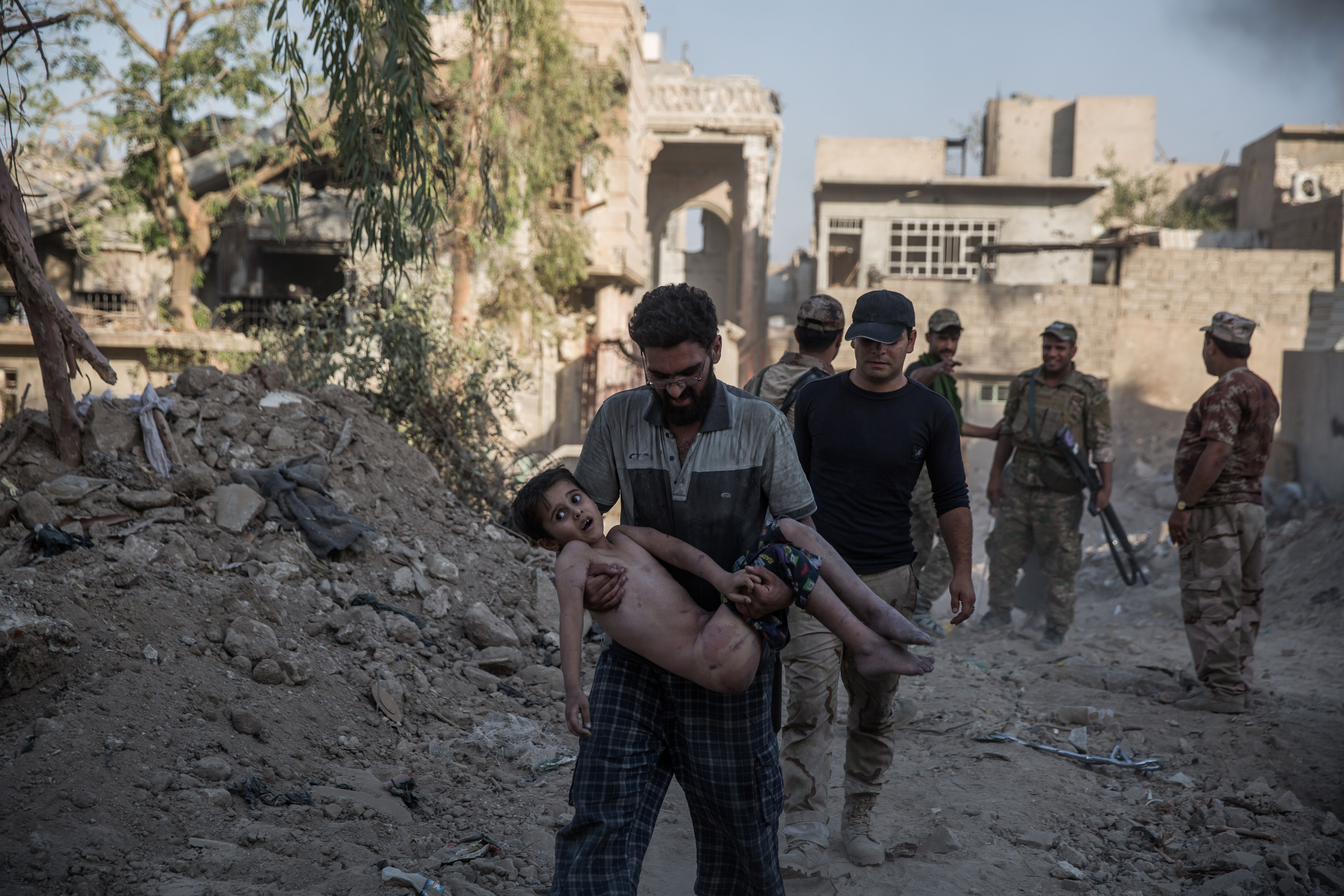
West Mossul July 5, 2017, Men and women flee the fighting in the old city. Here a man and his injured son who looks bad in point.
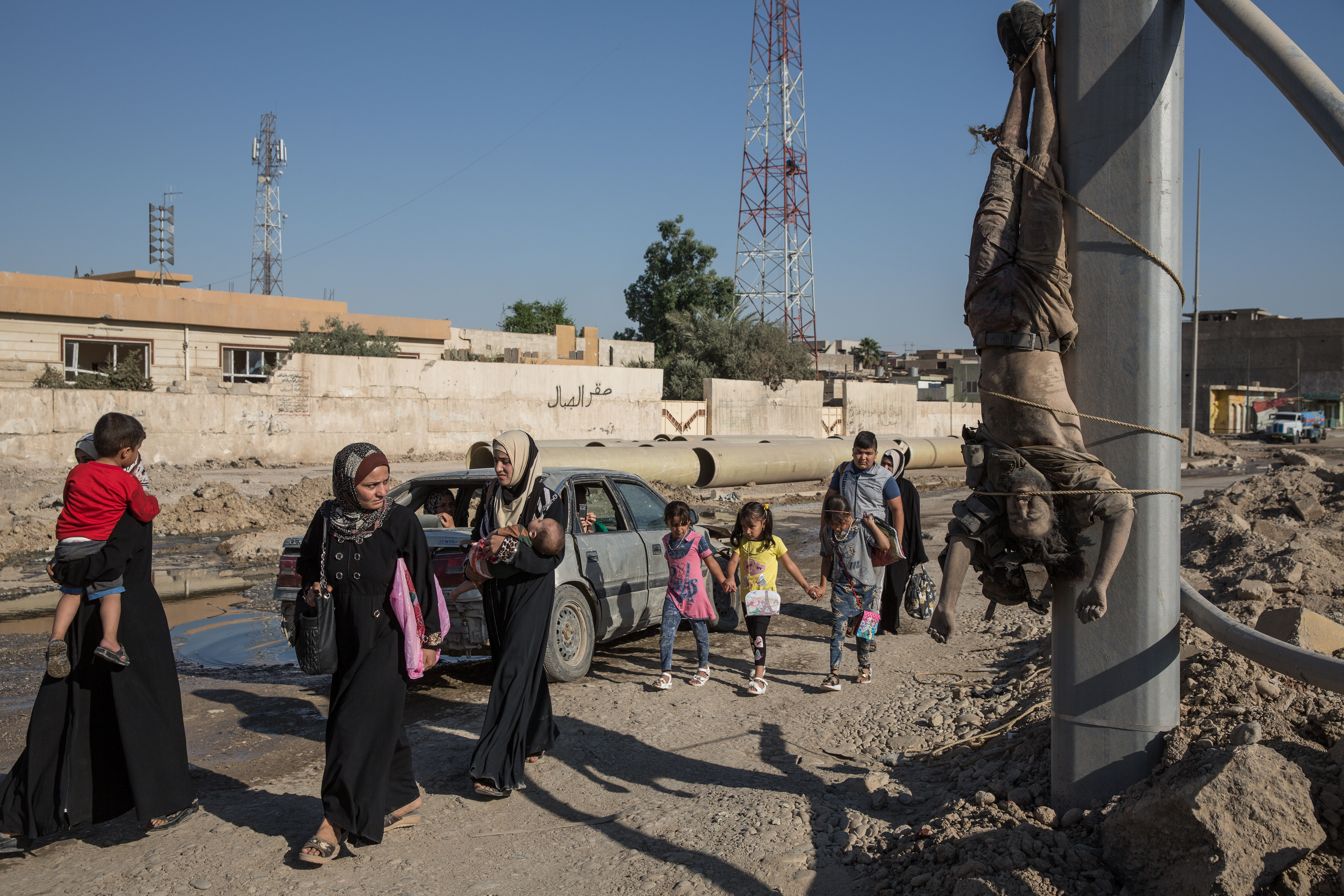
West Mosul. On June 26, 2017, the body of a jihadist is hanging on a pole in a busy intersection of the city. The previous night, sleeping cells of Daesh did various counterattacks in liberated West Mosul neighborhoods. The Iraqi army hangs the body of one of the jihadists, in order to humiliate the enemy. Civilians and children attend this show. Later the body will be unhooked and lynched with stones.
Finalists
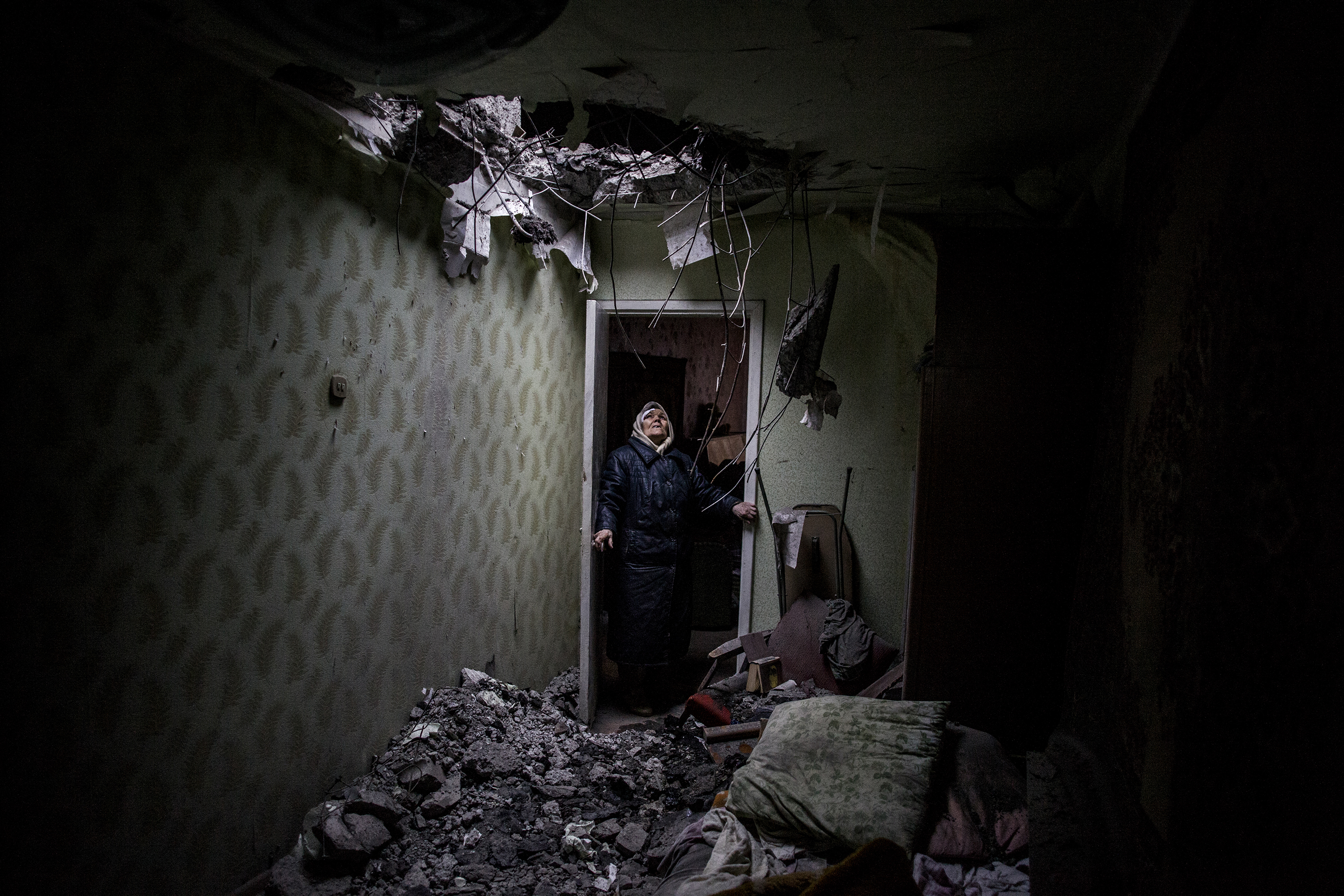
Galina, 86, looks at the hole made by an artillery hit on her apartment in Kievsky district in Donetsk, Ukraine. Tuesday, January 21, 2015
Manu Brabo
Il reportage finalista | The Last European Frontlines
DESCRIZIONE DEL PROGETTO
Sono passati quasi 5 anni dalla rivolta nelle Regioni di Donetsk e Luhansk nell’Ucraina Orientale. Da allora, l’esercito ucraino (supportato da diverse milizie nazionaliste) ha combattuto i ribelli sostenuti dalla Russia della cosiddetta Repubblica popolare di Donetsk e della Repubblica popolare di Luhansk. Il conflitto, nonostante il cessate il fuoco in essere dal febbraio 2015, si è intensificato durante i primi mesi del 2017, secondo gli ultimi rapporti. La guerra rimane per lo più statica, trasformando il paesaggio in qualcosa di simile alla prima guerra mondiale, con trincee e posizioni di mitragliatrici lungo tutta la linea di contatto. Dopo quattro anni, questa guerra in Europa non sembra avvicinarsi alla fine. Una Russia potente e bellicosa e gli eventi in corso in alcune altre parti del mondo hanno relegato questo conflitto nell’oblio, anche per gli stati confinanti. Nel frattempo, secondo il Governo ucraino, la guerra ha lasciato circa 10mila morti e 30mila feriti, oltre a oltre un milione di sfollati.
Manu Brabo (Manuel Varela de Seijas Brabo, 1981) è un fotoreporter freelance il cui lavoro si concentra sui conflitti sociali in tutto il mondo. Dal 2007 lavora sugli sconvolgimenti politici, rivolte e guerre in Paesi come Haiti, Honduras, Kosovo, Libia, Egitto, Siria o Ucraina, tra gli altri. Negli ultimi dieci anni, Manu Brabo ha collaborato con diverse agenzie di stampa come The Associated Press, con The Wall Street Journal, las Docg Without Borders, Ocha e alcune Ong. I suoi lavori sono stati esposti in diverse istituzioni in Europa e in America e sono stati premiati con il Premio Pulitzer, il Picture of the Year e il British Journalism Awards, tra gli altri.
The finalist | The Last European Frontlines
PROJECT DESCRIPTION
It’s almost 5 years since the uprising in the Donetsk and Luhansk regions in eastern Ukraine. Since then, the Ukrainian army (supported by several nationalist militias) has been fighting Russia-backed rebels from the so-called Donetsk People’s Republic and Luhansk People’s Republic. The conflict, supposedly under a cease-fire since an agreement in February 2015, has been escalating during the first months of 2017, according to the latest reports. Yet the war remains mostly static, transforming the landscape into something resembling World War I, with trenches and machine-gun positions all along the contact line. After four years, the only war in Europe doesn’t seem to be approaching an end. A powerful and bellicose Russia and the events going on in some other parts of the world have relegated this conflict to oblivion, even for Ukraine’s European neighbors. In the meantime, according to the Ukrainian government, the war has left around 10,000 dead and 30,000 wounded, as well as more than a million internally displaced.
Manu Brabo (Manuel Varela de Seijas Brabo, 1981) is a freelance photojournalist whose work is mainly focused on social conflicts around the world. Since 2007 he has been working on political upheavals, uprisings and wars in countries like Haiti, Honduras, Kosovo, Libya, Egypt, Syria or Ukraine among others. During the last ten years Manu has contributed to several news agencies as The Associated Press, outlets like The Wall Street Journal or NGO’s las Doctors Without Borders or the OCHA His work has been exhibited by many different institutions in Europe and America and his work has been awarded with the Pulitzer Prize, the Picture of the Year and the British Journalism Awards among others.
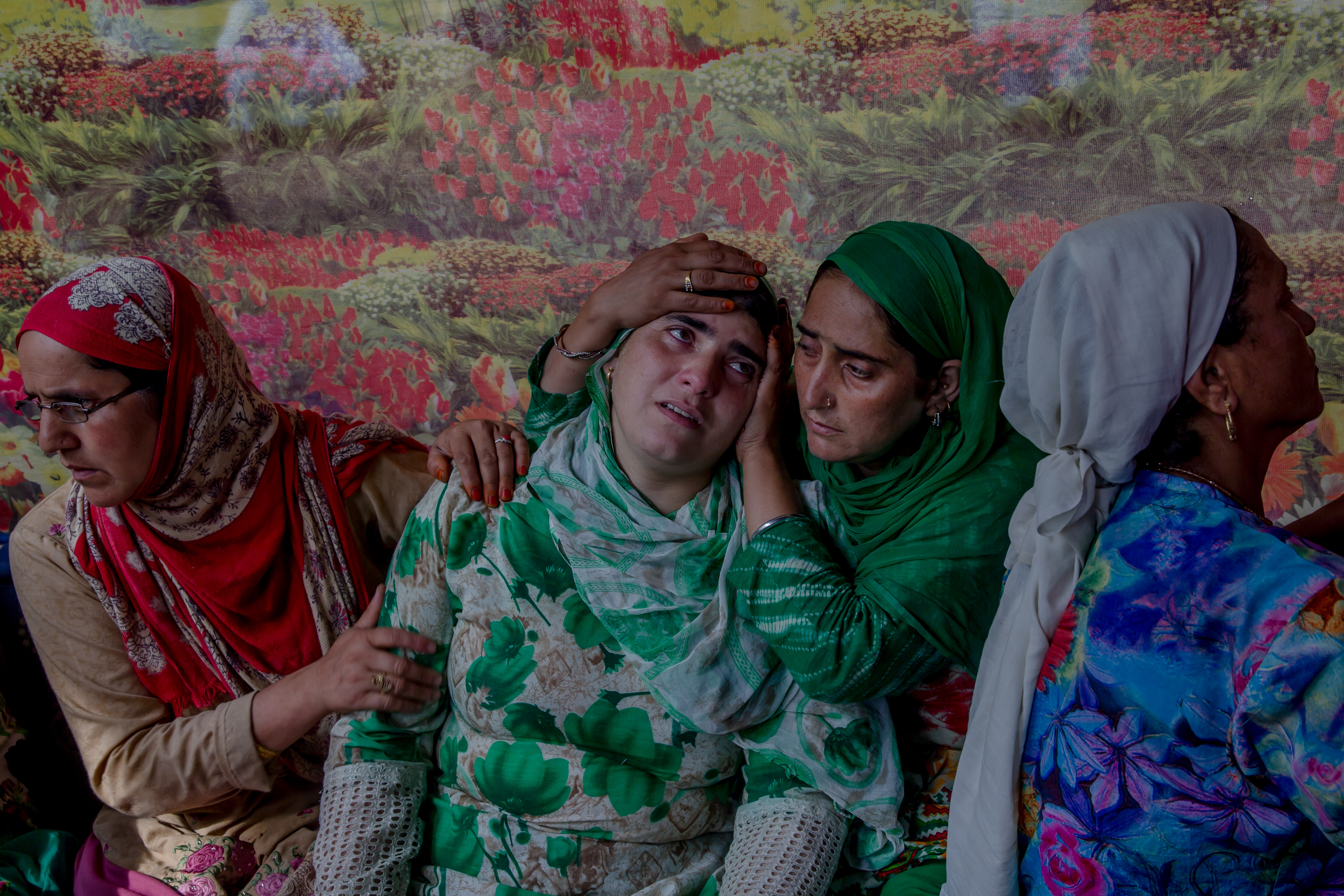
Unidentified relatives comfort the wailing sister of a Kashmiri civilian who was killed during protest near the site of gun battle at her residence in Begumbagh,, about 32 kilometers (20miles) south of Srinagar, Indian controlled Kashmir, Tuesday, Aug. 1, 2017. Large anti-India protests and clashes spearheaded mostly by students erupted in disputed Kashmir on Tuesday after government forces killed two senior militants in a gunbattle and fatally shot a protester during an ensuing demonstration demanding an end to Indian rule.
Dar Yasin
Il reportage finalista | Kashmir – Endless War
DESCRIZIONE PROGETTO
L’India affronta la crisi del Kashmir dal 1947, quando l’India e il vicino Pakistan hanno ottenuto l’indipendenza e hanno iniziato la prima di due guerre che avrebbero combattuto per le loro rivendicazioni rivali nella Regione a maggioranza musulmana. L’India accusa il Pakistan di armare e addestrare i ribelli ad attraversare il confine pesantemente militarizzato che divide la Regione tra i due Paesi. Il Pakistan nega l’accusa e afferma di offrire ai ribelli solo un sostegno morale. La maggior parte delle persone nel territorio diviso controllato dall’India è favorevole all’indipendenza o alla fusione con il Pakistan. Gruppi ribelli combattono nella regione dal 1989 e più di 68mila persone sono state uccise nella rivolta armata e in seguito alla repressione militare indiana.
Dar Yasin, nato nel 1973, nel Kashmir indiano. Ha studiato informatica e tecnologia nel Sud dell’India. Come fotografo Dar ha coperto il conflitto del Kashmir, il terremoto della Terra in Asia Meridionale, le sue conseguenze e la storica apertura della linea di autobus tra il Kashmir diviso. In Afghanistan attraverso i suoi scatti ha raccontato la guerra, la situazione dei rifugiati e la vita quotidiana dei civili dilaniati dalla guerra. Dar ha anche coperto la crisi dei rifugiati rohingya fuggiti dalla violenza su vasta scala e dalle persecuzioni in Myanmar. Le sue opere sono apparse in quasi tutti i principali quotidiani e riviste di tutto il mondo. Ha vinto dozzine di premi fotografici internazionali e nazionali tra cui POYi, Atlanta Photojournalism, China Press Photo contest, National Headliner Awards, Sigma Delta Chi Award dalla Society of Professional Journalism. E il più prestigioso premio Ramnath Goenka indiano due volte per le storie del Kashmir. Dar faceva anche parte del team dell’Associated Press che ha vinto l’Hal Boyle Award per il Rohingya Exodus nel Overseas Press Club e un Robert F. Kennedy Award nella categoria International Print. Più recentemente ha ricevuto il premio umanitario Nppa (National Press Photographers Association) che viene assegnato a una persona per aver svolto un ruolo chiave nel salvare vite.
The finalist | Kashmir – Endless War
PROJECT DESCRIPTION
India has faced a separatist challenge in Kashmir since 1947, when India and neighboring Pakistan gained independence and launched the first of two wars they would fight over their rival claims to the Muslim-majority region. India accuses Pakistan of arming and training rebels to cross the heavily militarized border that divides the region between the two countries; Pakistan denies the allegation and says it offers the rebels only moral support. Most people in the Indian-controlled portion of the divided territory favor independence or a merger with Pakistan. Rebel groups have been fighting in the region since 1989, and more than 68,000 people have been killed in the armed uprising and ensuing Indian military crackdown.
Dar Yasin, born in 1973, in Indian Kashmir. Studied bachelor’s in computer science and technology in South of India. Dar has extensively covered Kashmir conflict, South Asia Earth Quake and its aftermath. Historical opening of bus route between divided Kashmir. On assignment in Afghanistan has covered Afghan War, Afghan Refugees and Daily life of war-torn Afghanis. Dar has also covered Rohingya refugee crisis who fled large- scale violence and persecution in Myanmar. His works have appeared in almost all the major newspapers and news magazines around the globe. Dar has won dozens of international and national photo awards including POYi, Atlanta Photojournalism, China Press Photo contest, the National Headliner Awards, the Sigma Delta Chi Award by the Society of Professional Journalism. And Indian’s most prestigious Ramnath Goenka Award twice for the stories from Kashmir. Dar also was part of the Associated Press team that won the Hal Boyle Award for the Rohingya Exodus in the Overseas Press Club and a Robert F. Kennedy Award in the International Print category. Most recently he received NPPA (National Press Photographers Association) Humanitarian Award which is presented to an individual for playing a key role in the saving of lives or in rescue situations.
Honorable Mentions
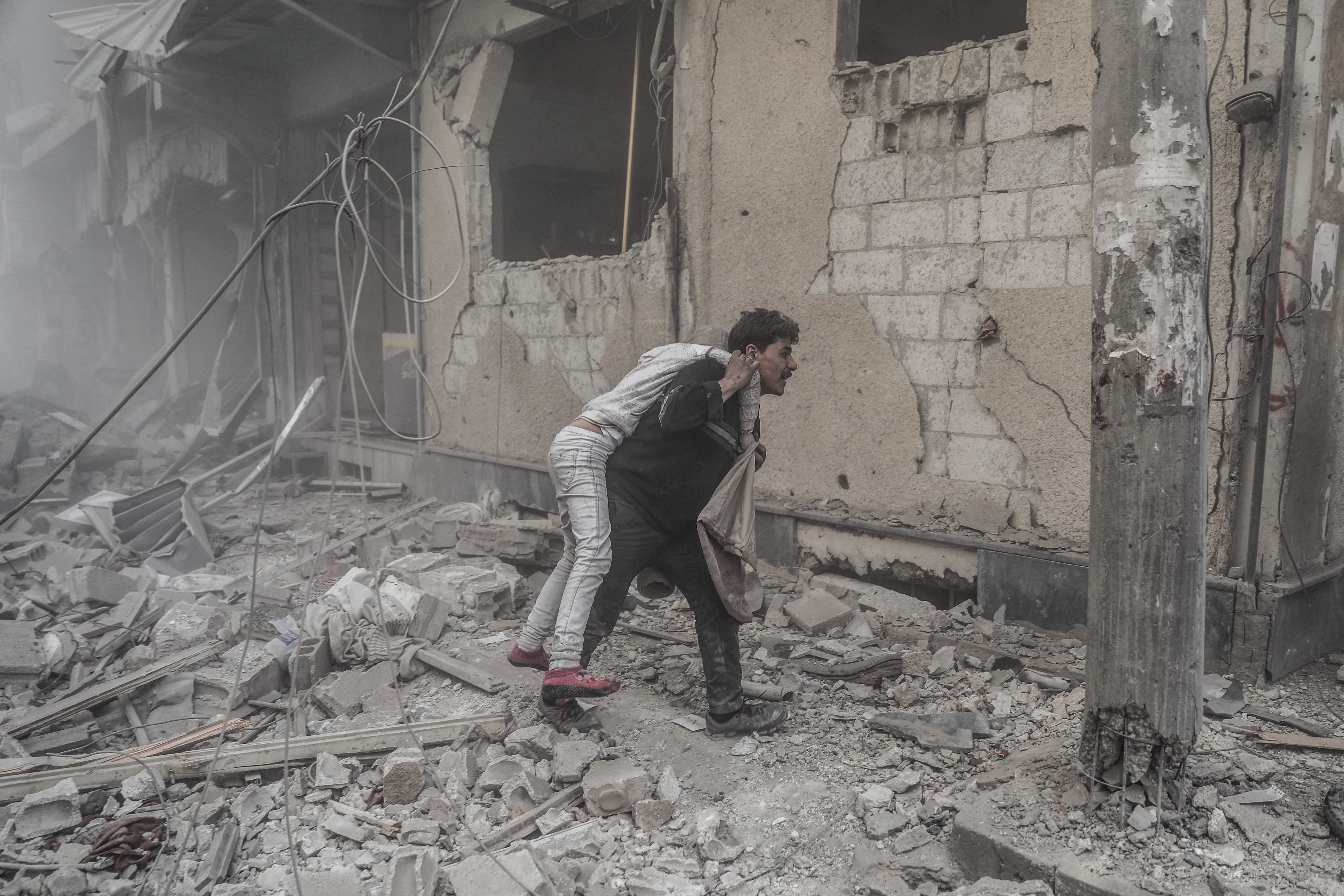
A young syrian man carries the wounded child after airstrikes by the syrian government forces on Douma city.
War Note by Sameer al-Doumy
In the war, life has a different meaning, everything about the normality will just disappear. The daily routine is definitely abnormal, even if it seems normal for people who live there. Every day, bombs fall, people die, buildings will be destroyed. The reality of war cannot be denied. However, there are people who are significantly trying to resist the bitterness of this terrible war by their determination, hope and desire to live.
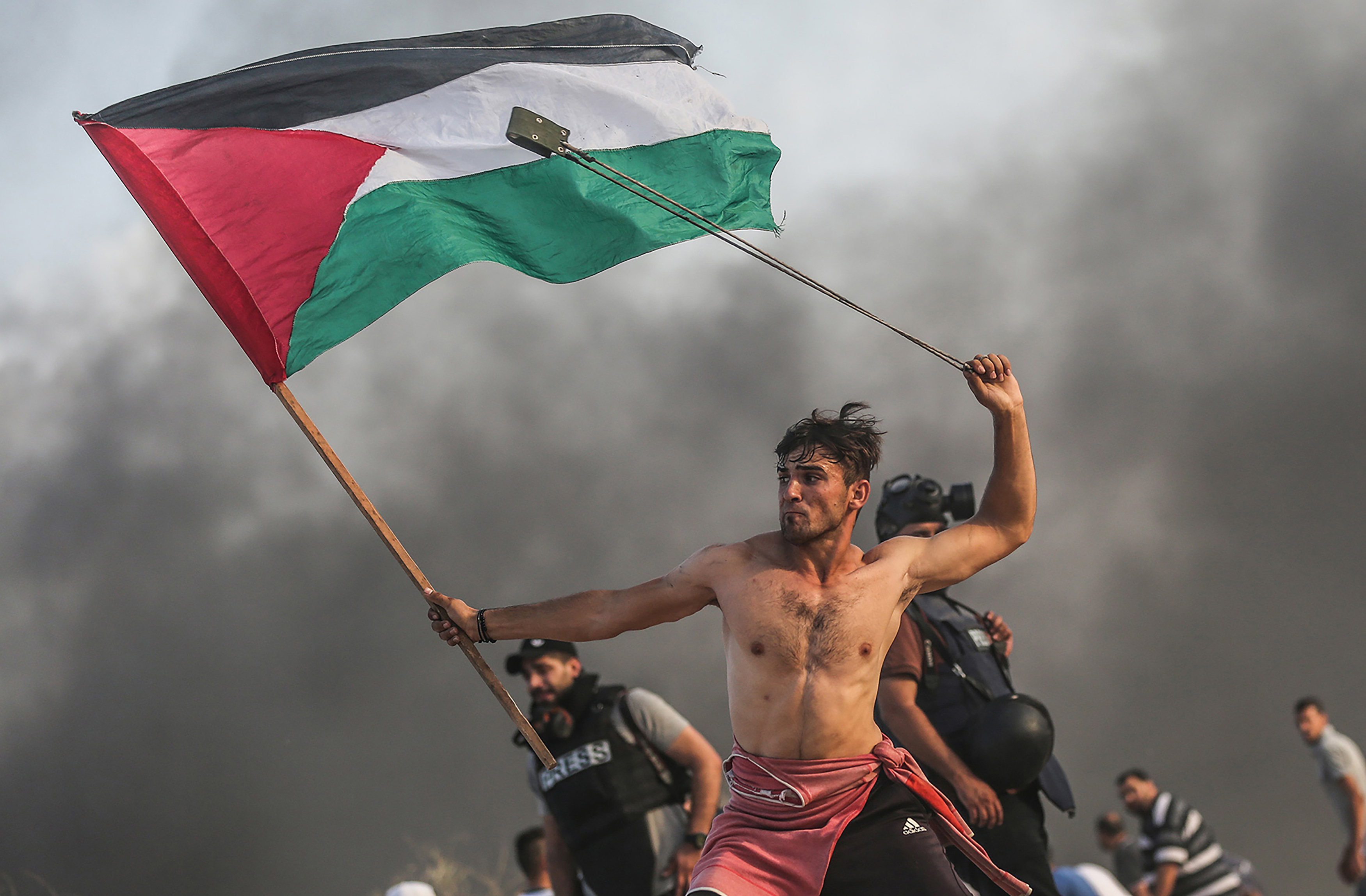
A shirtless young protester in Gaza gripping a Palestinian flag with one hand and swinging a slingshot over his head with the other, on the northern border between Gaza Strip and Israel in the weekly protests, which are organized by Palestinian protesters to protest against the Israeli blockade of Gaza which is imposed by Israel for 12 years until now.
Palestinian rights of return protests by Mustafa Hassona
Since 30 of May 2018 Palestinian protesters protested weekly on the border with Israel in order to demand for their rights of return, the protests till now is continuing where around 233 Palestinian protesters were killed and 21.000 were injured by Israeli snipers along the border area of Gaza Strip with Israel.





